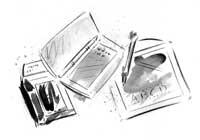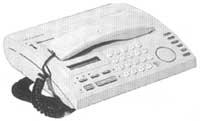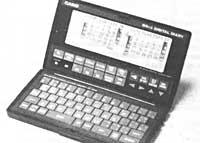The latest technological revolution
1993/05/01 Sagarna, Andoni - Ingeniaria Iturria: Elhuyar aldizkaria
Qualitative leap in the use of information
I remember the impression made by the first Macintosh computer eight years ago. Although at that time I had only two applications, the MacWrite word processor and the MacPaint drawing application, the machine seemed totally revolutionary to me. Giving orders using the mouse and icons put the use of the computer to any access. I can say without shame that I fell in love with that machine from the first glance. Then we have seen that the world of compatible PCs has approached this philosophy through Windows.
Now Apple Computer seems to me a new revolution, Newton technology. It will once again be one of those who do not see clouds because it looks to the ends of the shoes, which will tell us that it is nothing more than a toy. A near future will teach you how wrong you were.
The philosophy under this new technology is as simple as pencil and paper, but we need products with a large storage capacity, processing and information communication.

Apple's Newton technology is a new software and hardware. He has worked for the past four years. The starting point was to analyze how we handle information people.
To use the machine you write on the screen with a pencil. Therefore, the keyboard is not necessary. It is written as on paper. What you write by hand is entered into a text file that converts handmade drawings into ordered diagrams and graphs. If you make a cross over something, you will understand that it must be removed. Organize the search for what you keep. In addition, it has the ability to communicate with other computers or printers, faxes, phones, etc., either wired or wired.
Core competencies
All capabilities are aimed at making the machine (more than a tool) an auxiliary. Imagine that you used your Newton to write a letter. You can ask her to give her the look she has made up below. To fulfill this mandate, you will know your manual writing and turn it into make-up text. Then you will put the text in commercial letter format, e-mail. add date, return and bounce address. If you then ask Jon Agirre to fax it, only he will perform all the necessary tasks, that is, find the fax number of Jon Agirre, make the call and send the letter, once the first page is completed.
If you write on the screen “Friday Eats with Ane” Newton has enough intelligence to know that you want to write the data on the agenda. He also knows that he wants meals to be both and that he usually takes an hour to eat with Ane. When you say on Friday that you are talking about this week and not the next one. Taking all this into account, you will write down the data on the agenda and teach you what you have done to accept it if you agree and, otherwise, to make the change you have said. As the date approaches it reminds you.
How to work
Newton does not stop observing what you do and looking for ways to help you. You are also waiting for information to help you sort and work.
When something happens, for example when you call “fax Jon Agirre,” Newton will interpret this phenomenon by comparing it to the facts and situations that have occurred before it. It contains in your memory a series of actions that you want to carry out. One of them can be fax sending. You will choose among other possible actions. Then the action will begin, preparing the fax in this case. If you misunderstand or start performing the action the way you wouldn't want, you can give it corrections. At the end of the task, Newton takes note of what he has seen, so that next time the work becomes cleaner and faster.
This intelligence can be used to distribute news or search for articles on a specific topic on an electronic network.
Knowledge of manual writing and drawing
Newton does not require that the letters of the printing press be used manually. Manual writing can be done in the same way as on paper, with complete freedom, using drawings or numbers. Newton puts these drafts in order. If you type a few numbers in the column and make a stripe below, Newton will automatically join them. Other operations can be math.
Knowing the manuscript characters is not a joke job. There are very similar letters zero and o, sign + and t, etc. Newton has knowledge of characters, numbers and graphs, as well as specific knowledge of the commands he writes. Given the context, symmetry and what has already been interpreted, connoisseurs interpret together what you write. Great accuracy in interpretation. Progressively modules will be developed for the interpretation of continuous writing, musical notation, commands given in different languages, symbols of electronics, scientific and mathematical notation and even speech.
With the passage of time Newton will adapt to the style of the user, that is, he will know better the letter of the user and will learn from the correction of errors that cometa.
Organization of information
Newton can also handle well-structured information, such as the one we currently introduce into a database, and free information, which we still do not know how we will organize it and with what other things. Because he helps us organize.
Communications
Newton products allow you to send and receive information from anywhere. Easy connection to phone lines, computer networks and wireless networks.

Gai honi buruzko eduki gehiago
Elhuyarrek garatutako teknologia





